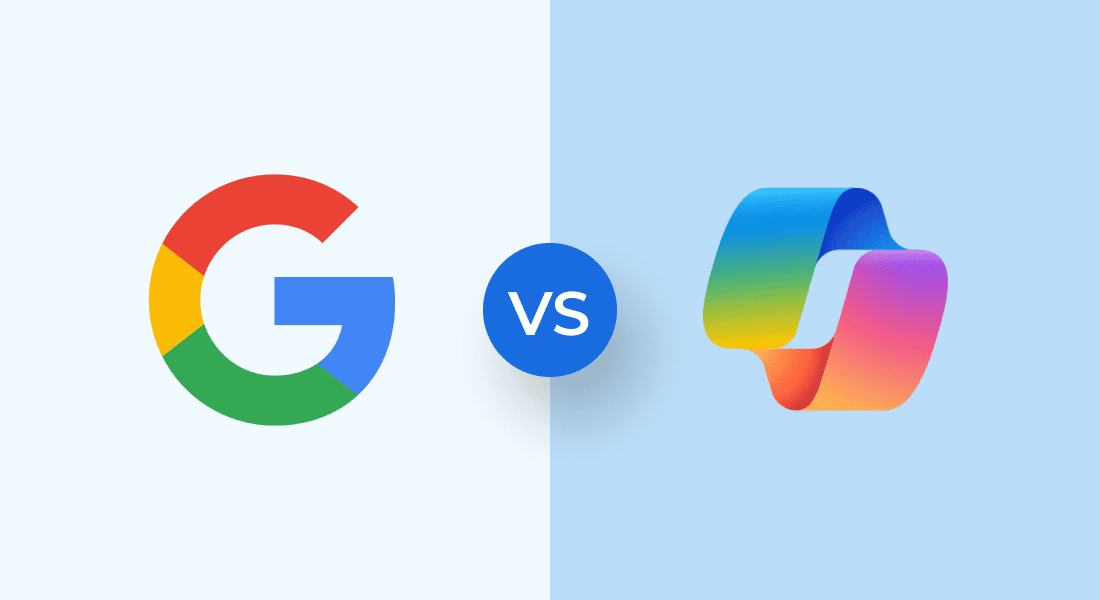Key highlights
- Explore the core differences in Google Workspace vs Microsoft 365, including productivity apps, cloud storage and collaboration tools.
- Learn which platform better supports small business workflows, whether you value an intuitive interface or advanced features.
- See how Google Workspace integrates with Google services like Search Console Insights, Google Analytics and Drive for smarter business decisions.
- Compare Google Workspace vs Office 365 pricing, security features and desktop app availability.
- Discover how Bluehost simplifies Google Workspace setup, including domain connection and 24/7 support.
Introduction
Your business is growing and so are your needs. Now’s the perfect time to ensure your team has the right digital tools to stay productive, connected and secure. Whether it’s managing emails, sharing files, scheduling meetings or storing documents safely, the right productivity suite can make all the difference.
With so many options available, it often comes down to the decision of Google Workspace vs Microsoft 365 for productivity. Both platforms support communication, file sharing and collaboration tools, but in very different ways. The right choice depends on how your team gets work done. That includes whether you work remotely, in the office or somewhere in between. It also depends on which tools your team already knows and prefers.
In this guide, you will find a detailed Google Workspace vs Microsoft 365 comparison of features, pricing and security options. You’ll also explore key integrations to help you make the best choice for your business, from desktop apps and cloud storage to real-time collaboration, data protection and more.
Quick overview: Google Workspace vs Microsoft 365
Choosing between Google Workspace vs Microsoft 365 depends on your business’s needs and collaboration style. Both platforms offer cloud-based tools for email, document management and collaboration, but they differ in features, pricing and user experience.
Let’s dive into a detailed comparison to help you decide which platform aligns best with your goals.
Understanding Google Workspace

Google Workspace, formerly G Suite, is a cloud-based productivity suite designed for easy, real-time collaboration. It includes tools like Gmail, Google Docs, Drive, Sheets, Slides and Google Meet. All these core apps work together across devices for seamless productivity.
What sets Google Workspace apart is its integration with Google services. You can access Search Console Insights, Google Analytics and Google search reports while working. Real-time data like top search queries and trending search queries help businesses make fast, informed decisions, especially when analyzing search engine performance.
With the Android Google app, managing your Google Workspace tools on the go becomes even easier. At Bluehost, we’ve made it even simpler for you to integrate Google Workspace with your website and domain. By activating it directly from your hosting dashboard, you can avoid third-party apps and get everything working in one place.
Your email, files, calendar and documents will be seamlessly integrated, providing a cohesive solution for all your business needs. Plus, we provide 24/7 expert support to ensure you can focus on what matters most. For businesses seeking enhanced security features, Google Workspace offers scalable solutions for teams of multiple users through its Enterprise and Business Starter Plan options.
Also read: How to Set Up Google Workspace: Initial Setup Guide
Understanding Microsoft 365

Microsoft 365, formerly Office 365, is designed for businesses that need advanced features, powerful desktop apps and robust security features. It includes Word, Excel, PowerPoint, Teams, Outlook and OneDrive, available both online and offline. This productivity suite is perfect for businesses handling complex documents or needing strong compliance controls.
When comparing Google Workspace vs Office 365, Microsoft 365 stands out for its desktop-first approach. It integrates well with Windows systems and offers deep offline functionality. Its advanced security and compliance features are great for businesses that prioritize data protection.
While Microsoft 365 doesn’t integrate deeply with Search Console Insights, it provides its own analytics. If Google search impact reports and trending search queries are essential for your business, Google Workspace may be the better fit.
Also read: Logging Into Microsoft 365: How to Sign in and Access Your Dashboard
How do the features of Google Workspace and Microsoft 365 compare?
Both Google Workspace and Microsoft 365 offer powerful suites of tools for communication, collaboration and productivity. But depending on your business size, workflow and tech preferences, one may be a better fit than the other.
Below is a side-by-side look at the key features, followed by a detailed breakdown of what each platform delivers.
Google Workspace vs Microsoft 365 feature comparison table
| Feature | Google Workspace | Microsoft 365 |
|---|---|---|
| Core apps | Gmail, Google Docs, Sheets, Slides, Google Meet | Outlook, Microsoft Word, Excel, PowerPoint, Teams |
| Cloud storage | 30GB to 5TB per user via Google Drive | 1TB to unlimited per user with OneDrive and SharePoint Online |
| File sharing & permissions | Easy sharing via Drive, granular permission control | Advanced sharing via OneDrive & SharePoint with access management |
| Collaboration tools | Real-time collaboration, Google Chat, Meet | Microsoft Teams, real-time co-authoring, comments |
| Email services | Gmail with custom domain, Google Workspace business starter | Outlook with custom domain, integrated with Microsoft Office apps |
| Security & compliance | Encryption, multi-factor authentication, Google Vault, basic DLP | Enterprise-grade security, Data Loss Prevention (DLP), eDiscovery, context aware access |
| User experience & support | Intuitive, user friendly, modern interface, online help | Familiar desktop apps, priority and phone support |
| Data privacy & protection | Aligned with Google security policies, Google Workspace enterprise plan | Microsoft Information Protection, advanced compliance tools |
| Pricing | Starts around $6/user/month, includes business starter plan | Starts around $6/user/month, multiple tiers with desktop apps |
| Best for | Collaboration, remote teams, productivity tools, cloud computing | Businesses needing advanced tools, offline functionality and compliance |
While both platforms offer strong productivity and collaboration tools, the best choice depends on how your team works. This Google Workspace vs Microsoft 365 comparison breaks down each feature to help you decide which suite better supports your business goals.
1. Core apps offered by Google Workspace and Microsoft 365
Google Workspace focuses on web-based apps like Gmail, Google Docs, Sheets, Slides and Google Meet. These tools are designed for real-time collaboration, allowing multiple users to work on the same document simultaneously. Everything is saved in the cloud, which reduces reliance on local storage or desktop software.
Microsoft 365 vs Google Workspace differs here, as Microsoft includes powerful desktop versions of Word, Excel, PowerPoint and Outlook. The desktop apps offer more advanced features for in-depth editing and formatting, appealing to users needing offline functionality and complex document creation. It also offers browser and mobile versions, but the desktop apps provide more flexibility for advanced work.
Also read: How to Set Up Microsoft 365 Apps
2. Cloud storage options and limits
Google Workspace includes 30GB to 5TB of cloud storage per user, depending on the plan, with storage tied to Google Drive. This setup is ideal for small businesses that rely on shared folders and cloud collaboration.
Microsoft 365, by contrast, typically offers 1TB per user via OneDrive and can scale to unlimited storage with higher-tier plans. SharePoint adds extra storage for team-based file organization and content management, making it a better choice for businesses with large file storage needs or complex workflows.
3. File sharing capabilities and permissions
With Google Drive, sharing is straightforward, users can quickly create shareable links or set access permissions by user or group. Admins can control link access (view, comment or edit), making collaboration simple and secure.
Microsoft 365 provides robust sharing via OneDrive and SharePoint, offering deeper integration with Teams and Outlook. Users can set expiry dates for links, restrict downloads or use advanced controls for sensitive data, which gives IT departments more control over file access and ensures tighter security.
4. Collaboration tools and features
Google Workspace thrives on simplicity and speed. Teams can co-edit Docs, Sheets and Slides in real time, add comments and jump into a Meet call instantly. Google Chat adds light messaging for daily coordination.
Microsoft 365, however, includes Microsoft Teams, a hub for chat, meetings, document sharing and video calls, all in one space. While both platforms support real-time editing, Teams bring stronger project-based collaboration, especially when combined with SharePoint.
5. Email services and management
Google Workspace uses Gmail, known for its clean interface, powerful search and integration with Google Calendar and Tasks. It supports custom business domains and offers spam protection and admin controls.
Microsoft 365’s Outlook is preferred by users who rely on advanced calendar tools, folders and offline access. It integrates deeply with desktop apps and includes a focused inbox, scheduling and robust admin tools, which many businesses find essential.
6. Security and compliance measures
Google Workspace provides strong baseline security: two-factor authentication (2FA), data encryption and secure admin controls. It also supports vaults for archiving and eDiscovery.
Microsoft 365 stands out with enterprise-grade compliance tools like Data Loss Prevention (DLP), Microsoft Defender and advanced auditing features. It’s often the preferred choice for industries with strict compliance standards, like finance or healthcare.
7. User experience and customer support
Google Workspace is known for its clean, modern interface that works well in browsers across all devices. Users typically face a short learning curve and support is available via documentation, help centers and email.
Microsoft 365 offers familiarity through its long-standing Office suite, though new users might find the interface more complex. Support options include live chat, phone support and priority assistance for higher plans, which can be a major plus for larger teams.
8. Data protection and privacy policies
Google Workspace aligns with Google’s overarching security and privacy practices, offering transparency, encryption and GDPR compliance. Businesses can monitor activity via the Admin Console and gain insights through Google search data, Google search console reports, Google search insights and Search Console Insights.
Access Search Console Insights to quickly understand which content performs best and how people find your website. Search Console Insights helps simplify SEO performance data, making it easier for small business owners to act on what matters.
Microsoft 365 offers Microsoft Information Protection, customer lockbox and customizable data retention policies, ideal for regulated environments that need stricter oversight.
9. Pricing and plan comparisons
Pricing for both platforms start at around $6/user/month, but the features vary by plan. Google Workspace pricing is generally more straightforward, with scalable storage and collaboration tools included.
Microsoft 365 offers more tiers with additional services like desktop apps and advanced security, but the cost can rise quickly based on features.
When comparing Google Workspace vs Microsoft 365 pricing, consider your long-term needs and preferred software environment. Pay close attention to desktop apps and security options, especially with the added features Microsoft 365 includes. A standout feature of Google Workspace is its seamless cloud-based experience, ideal for teams that need real-time collaboration.
10. Suitability for different types of businesses
When weighing Google Workspace vs Microsoft 365 for small business, think about your team’s structure, growth plans and daily operations. Google Workspace is ideal for startups, solo entrepreneurs and remote teams that prioritize cloud access, ease of use and real-time collaboration. If your business thrives on flexibility, fast setup and minimal IT management, Google’s ecosystem fits naturally.
Microsoft 365 is better suited for growing small businesses or those with more traditional office setups that rely on advanced desktop software like Excel, Word and Outlook. It’s a strong choice if you need robust data controls, compliance tools or integration with legacy systems.
How can you decide which platform is right for you?
Every business operates differently. Some prioritize collaboration speed, while others lean on deep functionality or more robust security features. The right productivity suite should align with your team’s habits, your business tools and your long-term growth goals.
Let’s explore some key considerations to help you determine which platform fits your business.
Assess your team’s workflow and collaboration style
Your team’s workflow is a critical factor in selecting the right platform. If your team thrives on real-time collaboration, Google Workspace may be the better option. Its suite of mobile apps and tools like Google Docs, Google Sheets, Google Slides and Google Forms makes collaboration easy, allowing multiple Google users to edit the same document simultaneously in Google Workspace environments.
If you need a more structured approach with complex project management capabilities, Microsoft 365’s Microsoft Teams provides a powerful collaboration hub for chat, meetings and document sharing. It also integrates with Power Automate, enabling advanced workflow automation.
Consider the types of tools your business already uses
Look at the tools your business currently relies on. Google Workspace integrates seamlessly with Google’s productivity suite and other Google services like Google Analytics, Google Ads and Google Apps Script. Businesses already familiar with Chrome browser and Google Workplace tools can benefit from tighter integration and AI tools designed to streamline workflows.
At Bluehost, we’ve made it even easier for you to integrate Google Workspace with your website and domain. By activating it directly from your hosting dashboard, you can manage business emails, calendars and documents all in one place. This reduces reliance on third-party tools while providing full data protection and endpoint management features to help safeguard against security threats.
On the other hand, if your business already uses Microsoft Office products like Word or Microsoft Excel extensively, Microsoft 365 may be the more natural fit. Both Microsoft desktop apps and cloud tools offer strong compatibility, particularly for enterprises requiring advanced file handling and more robust security features.
Evaluate your current and future storage needs
Consider the scale of your business and how your storage needs might grow. Google Workspace provides flexible cloud storage options ranging from 30GB with the basic plan to 5TB per user with higher tiers. This makes it a great fit for small businesses. For organizations with larger demands, Microsoft 365 offers scalable storage through SharePoint and OneDrive, including unlimited capacity at the enterprise standard plan level.
When you choose Bluehost hosting, you can seamlessly integrate Google Workspace, giving you a streamlined experience for managing both your website and productivity tools. This combination ensures that your data remains secure while simplifying storage management.
Factor in pricing and overall value
Pricing is always an important factor when choosing the right platform. Both Microsoft and Google Workspace start at around $6 per user per month, but they differ in structure.
Google Workspace offers a simple pricing model, with options like the business standard plan, making it cost-effective for startups and small businesses. Microsoft 365 often provides greater value for larger organizations that require desktop apps, Power Automate workflows and enterprise-level security.
At Bluehost, we understand the importance of simplicity, real-time collaboration and seamless integration with the tools you already use. That’s why we offer Google Workspace with our hosting services. It’s a powerful, cost-effective solution designed to help you streamline your business and boost productivity.

Also read: How to Choose the Most Scalable WordPress Hosting Plans
Final thoughts
The Google Workspace vs Microsoft 365 comparison highlights how your choice depends on the tools and workflows your team values most. While Microsoft 365 vs Google Workspace shows Microsoft’s strength in power apps and a large partner network, Google Workspace shines with intuitive management tools google workspace and real-time collaboration.
For small businesses, Google Workspace vs Microsoft 365 for small business often favors Google Workspace due to its seamless integration with core Google products like Gmail, Google Drive and Search Console Insights. Google Workspace works by offering a flexible, cloud-first platform that keeps your team connected and productive across devices.
With Bluehost, you can easily activate Google Workspace directly from your hosting dashboard, linking it to your domain and managing everything in one place, no technical skills required.
Ready to experience the power of Google Workspace and simplify your business operations? Get started with Google Workspace today and harness the productivity of the best collaboration tools available.
FAQs
It depends on your business needs. Google Workspace excels in real-time collaboration, cloud storage and an intuitive productivity suite, while Microsoft 365 offers powerful desktop apps, offline functionality and robust data protection features.
Google Workspace offers a simple, cloud-first Gmail solution with strong security features like multi factor authentication. Microsoft 365 suits teams preferring Outlook and advanced email management tools integrated with Microsoft Office desktop apps.
Google Workspace includes Google Meet and Google Chat for quick, easy communication and collaboration tools. Microsoft Teams delivers advanced collaboration with threaded chat, channels and deep integration with the Office apps ecosystem.
Microsoft 365 provides powerful desktop software, enterprise grade security and data loss prevention features. Google Workspace emphasizes ease of use, real-time collaboration and tight integration with Google Drive and Search Console Insights.



Write A Comment